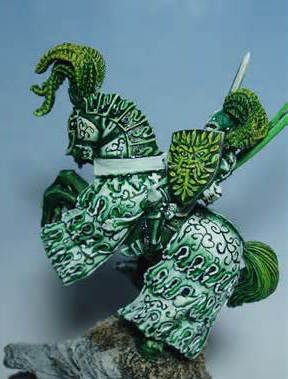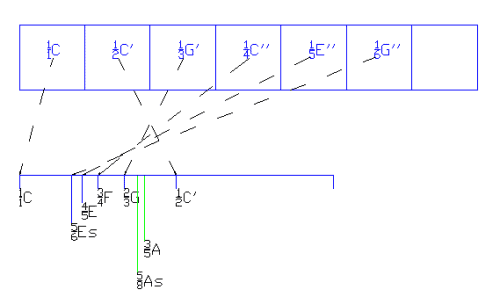“Any energy in a state of tension manifests other corresponding energies.”*
THIRD (MAJOR AND MINOR)
The fifth interval is called a THIRD in today’s technical language and demonstrates two qualities which do not appear in the other, superior, intervals or are unexpressed and latent. Each has an immense importance, both conceptual and practical, and must be clearly understood.
A) For the first time we see a “bifurcation”: the THIRD is differentiated, or splits, into major and minor.
4/5 E : 5/6 Es (frequencies)
Major THIRD Minor THIRD
Both these sounds are in fact the “third note” starting from the tonic C. In the first case, three tones are counted, C, D, E; in the second, two tones and a semitone: C, D, Es.
This split has innumerable repercussions and is sufficient by itself to explain the causes of infinite phenomena of the manifested world and of the psyche. And it must be stated immediately that, starting with the THIRD, all the other intervals have this same characteristic, which it is however reasonable to see as derived from it, as the great dualistic principle.
In fact, it is a question of a real manifested dualism, and not a latent one, as noted before with the octave, the fifth and the fourth. Here two distinct ways of expression of Being appear: the intrinsic poles of the octave here come out, so to speak, into the sphere of the explicit. From now on, in the development of sound, everything will be twofold, and many times twofold, with the birth of inevitable double relationships and, in short, of complexities. But here, at the level of the THIRD, the situation, even though complicated, is still clear; and it is possible to read in it attentively the causes of the following general doubleness, as well as the ways to transcend it.
 Bifurcation, branching, splitting, differentiation and dualism are terms with which an attempt is made to describe the appearance of this element. The THIRD operates dialectically, contrasts, analyses, discriminates, weighs up, discerns, divides and holds a dialogue. One can see in it, distorted, the cause or the mother of all the intervals, not in their essence (which is unitary and synthesizing) but in their appearance, which is of two sounds or, in general, involves a basic dualism. Better still, one can say that the THIRD is the mother of form, as it introduces that dualism which is indispensable to its appearance and continuance.
Bifurcation, branching, splitting, differentiation and dualism are terms with which an attempt is made to describe the appearance of this element. The THIRD operates dialectically, contrasts, analyses, discriminates, weighs up, discerns, divides and holds a dialogue. One can see in it, distorted, the cause or the mother of all the intervals, not in their essence (which is unitary and synthesizing) but in their appearance, which is of two sounds or, in general, involves a basic dualism. Better still, one can say that the THIRD is the mother of form, as it introduces that dualism which is indispensable to its appearance and continuance.
Consider the imposing accumulation of consequences: all that has a form can be traced in some way to this peculiar, twofold interval; even a thought, in so far as it is specific and so formal, has an appearance and falls within its empire, or its law. Thought has in fact a twofold nature: it can be abstract or concrete, that is universal and unitary, or dualistic. This last aspect is the product of the intellect, the reason, and reasoning and it is the mental activity which is by far the most common for modern man. Its characteristic is precisely distinguishing between true and false, between right and wrong and between every kind of opposite: it analyses and contrasts, judges, weighs up, confutes and supports; and continually puts forward problems without ever solving one of them. It is incapable of synthesis; it is partisan or agnostic; it is the forge of doubt, hesitation and perplexity. It is the father of concrete science, the glory of modern humanity, but also the cause of his moral poverty.
All intellectual work is dominated by the action of this interval; the mind itself, with its two great categories (abstract and dualistic) sets itself, as fifth principle, under the governance of the THIRD.
The distinction which is produced at this level and which then has repercussions on all the other following manifestations has, however, another great effect: the separation of creation into two separate and complementary spheres, which can be called, in musical terms, the major world (masculine, positive, active and creative) and the minor world (feminine, negative, receptive and nutritive). The THIRD, in fact, is the interval which is the first to split into major and minor: a bisexuality thus arises which did not exist before, with the reciprocal game of attraction and repulsion.
We cannot, in a few pages, extend or go deeply into the examination of this reality and its effects, which condition all the kingdoms of nature (even the mineral kingdom where, in the atom, the game of the opposites is found betwen the nucleus and the electron) and thus all that is manifest and perceptible. Let it suffice to consider that everything is traceable to an action of the THIRD, and that, though inevitable in the development of sound and so of creation, it is only the tangible expression of the inner unity, which continues unmanifested, but present and real. The THIRD, with its vibration, veils Reality, clothing it with form. Thus the Ideas, once they are thought of materially, take on a mental aspect and become perceptible to the masses, but their light is dimmed. From the world of absolute values they come down into the sphere of meaning and this, in so far as it is dualistic, is relative. On looking closely, the THIRD, the interval which is par excellence manifesting, formal and dualistic, is destined by nature to remain unknown or hidden. In fact, this fifth Principle never manifests itself: its appearances take up a place in the concrete world, they are either positive or negative, either major or minor, but the THIRD, their source, is unknown. It is not, in fact, either the minor or the major THIRD but the hidden cause of both. We will be compelled to speak of one or the other of its aspects, but remembering that in reality it is neither one nor the other, but the synthesis of both.
B) For the first time, it is noted that this interval, in its two aspects, is not acoustically “exact”. The ear, whether it is particularly sensitive or not, declares as a THIRD not a precise vibration but a group of vibrations; in fact, the little bridge, on the monochord, can be moved by several millimetres to the right and to the left of the exact point of 4/5 and of 5/6 without a clear impurity or dissonance being registered. All those divisions of the string “are alright” as a THIRD. It is as if, around the right tonal relationship, a “sphere of action”, equally valid as a THIRD, whether major or minor, were manifested.
Third Major:
Third Minor:
This phenomenon takes on great importance: until now the other intervals (unison, the octave, the fifth and in consequence also the fourth, which is complementary to it) had expressed a remarkable exactitude, if not an absolute precision. Even conceptually, in fact, one cannot think of an approximate octave or a unison which is less than perfect. The THIRD on the other hand allows, and perhaps imposes, a different situation: imprecision is the accepted rule. In the kingdom of the three minor intervals (these remarks, in fact, concern also the sixth and the tone) precision and mathematical exactitude are no longer respected, but a state of ambiguity slips in.
This explains many things but above all it reveals a different requirement: the need and the function of tolerance. Harmonics is an exact science, to the point that it identifies where exactitude is strict and where compromise is right and proper. The three greater intervals (and the fourth with them) do not permit ambiguity: everything is clear, sharp and unequivocal in the kingdom of the three primary principles. Here tolerance and compromise would be useless or unbearable vices and errors. But in the sphere of the three minor intervals tolerance is not only admitted but is an unavoidable requirement. This does not mean the renunciation of the search for the perfection of the relationship, but the use of compromise as an element of balance and adaptation.
All the world of these three intervals is made ambiguous by this reality: but such a condition can and must be overcome with the appropriate means: not by having recourse to exactness, which here, if not impossible, is rare – but to patient tolerance, to the capacity to adapt oneself, to illuminated compromise. These are virtues in the dualistic world of form, but they would be vices in the higher sphere of being. This clarifies a serious problem that disturbs many consciences, which recognize the necessity of compromise yet recognize the defect in it: Harmonics, alone among the sciences, determines with precision where and when it is right and resolving and where and when it is ignoble and corrupting.
***
 “A majestic Unity reigns in the Universe as a most powerful law. Only the person who respects it can really cooperate with the Cosmos.”
“A majestic Unity reigns in the Universe as a most powerful law. Only the person who respects it can really cooperate with the Cosmos.”
With the foregoing we have thrown light, if only partially, on the two great distinctive characteristics of the THIRD: dualism and ambiguity, which is a kind of corollary to it.
To return now to the examination of the primary qualities of this interval, we shall say that it is the fifth principle, the mind, the FIFTH Ray. It is the Lord of concrete Science, of reasoning, of logic. It is the first form (revealed). It is the five. It is the one who bifurcates and chooses, who branches and divides. It is the Author of the world of the forms, innumerable and opposed to one another. It is the Lord of Thought, the first energy gifted with form, the creator of all the others, more dense and material.
The THIRD hides the light, but to reveal it, not to extinguish it. It presides over all researches, experiments and laboratories.
It is the mystery of dual action, of the nuptial, of the meeting of what is divided. It is the Logos, the Sound from which is born what is perceptible to the reason, the sentiments and the senses. And as every interval is by nature dual, the THIRD is the Lord of all the manifested intervals, it is the Immanent.
These last statements may confuse, at the beginning, since a short time ago it was learnt that UNISON is the real creator. But UNISON is and remains unmanifested, and with its three major aspects (unison, octave and fifth) it is the Transcendent. The THIRD is on the other hand the origin of all that, having a form, has an appearance and encloses and expresses a limited reality. Here lies a fundamental distinction, which yet links the five to the one.
It is suggested that the colour of the THIRD is orange, as the fusion of the two primary colours: red and yellow. But it is not clear what colour to propose for the major or the minor third separately. The former is not red and the latter is not yellow. But orange could be the light of the THIRD in itself, that unknown interval which expresses itself in two different ways.
“The consciousness which responds to cosmic attraction creates forms of psychic life. The commitment put into achieving the state of right resonance is a sign of responsibility of the spirit.”
MAJOR AND MINOR SIXTH
Just as the fifth has the fourth as a complement, so the major and minor third have the minor and major sixth, respectively, as complements.
Here a number of consequences appear which have a paradoxical element. It must be observed, first of all that, while the fourth (complementary to the fifth) is one of the higher harmonics generated spontaneously from the fundamental tonic and has its proper place next to the fifth, the same cannot be said for the sixths. The sixth interval or the sixth harmonic appears in the value
1/6 G’’ (lengths)
which composes, together with the preceding 1/5 E’’ an interval of a minor third, and not of a major sixth.
The question is delicate and seems to confirm the truth of that affirmation according to which “the sixth principle does not exist”, but has an illusory appearance.
One could also consider them in the same way as the two thirds, as if they also were thirds, given the close link of double reciprocity which connects them. But listening to them contradicts this assumption, because the psychic value of the sixths is autonomous and performs a function of its own.
Sixth Major:
Sixth Minor:
Here then is a condition of uncertainty and ambiguity, which perhaps is due to the intrinsic nature of the minor intervals and which one cannot do without – just as mists are frequent in the plains and are, after all, due to the nature of the places and their atmosphere.
With the sixths one has the impression of penetrating into a world which is more fantastic than real, yet convincing and present; it is like an enchantment which tests the capacity for reasoning, whose laws it distorts.
This sixth level, in fact, has inversion as a typical effect: this is revealed by the inverse correspondence between the minor third and the major sixth, and it is a characteristic which contains the seeds of disorientation. It is a question, also in this case, of a doubleness, but different from that encountered for the first time in the fifth principle, which we called bifurcation and which already separated in an illusory way what in reality is and remains unitary; here this same doubleness is, so to speak, aggravated by the reversal of the couples of opposites and it is easy to lose the way and remain trapped.
One must therefore be very cautious in crossing this singular domain, which puts the faculties of discrimination to a severe test; reality is here so veiled and distorted that one can be drawn to pursuing only its fleeting shadow, laboriously and with bitter disillusionment. What is positive here reveals itself as negative, the feminine has a masculine aspect and right takes on the appearance of wrong, and so on. Here is the dominion of illusion: instead of with Ideas, it is populated with idealisms, which draw one far away from the sunny fields of truth, disorient and hold one prisoner. Here fanaticism can be born; this is the land of partisans, sects and heresies; of sweet deceptions, desires and delusions.
 There is only one way to escape from this swamp, which allures and disperses: to keep to the middle way, where there are no inversions at all and the field of the opposed forces is in balance. Only on this narrow path does one avoid the enchantment of the sixths, the real sirens, Scylla and Charybdis.
There is only one way to escape from this swamp, which allures and disperses: to keep to the middle way, where there are no inversions at all and the field of the opposed forces is in balance. Only on this narrow path does one avoid the enchantment of the sixths, the real sirens, Scylla and Charybdis.
The whole of this situation at the sixth level, between doubleness, inversions, deceptions and disorientation, is such that it is the continual theatre of furious battles: the deluded fight through desired hopes and the disappointed fight to find the way out. Fray and confusion are added to the mists.
Yet the sixth principle has a function in reality. Its very nature is preliminary to higher conquests. Desire and sentiment (perhaps clearly expressed by both the sixths) are authentic vibrations, once the field is lightened and the mist dispersed. They are the natural complement to the intellect, the right moisture that tempers the dryness of reason. They are prodigious energies which stretch out towards the Ideas of the fourth level, the authentic complement, that is, real and orderly. These “desires” are the reawakening of the will on the way back. A very luminous desire is implicit in the very act of divine creation: this is undeniable and perhaps explains the real nature of the sixth principle; but it is necessary to purify it from the contradictions, the restlessness, the agitation and the false lights which immature minds perceive in it, disoriented by the inversion and dualism. It is a question, in brief, of false perspectives: but they are formed, like mirages, only because and when the real nature of the sixth principle is not known.
***
 At this point, what was said of the THIRDS can be repeated regarding the SIXTHS: the real interval of a SIXTH is unknown. This adds value to the preceding affirmations: the seat of illusions is not illusory.
At this point, what was said of the THIRDS can be repeated regarding the SIXTHS: the real interval of a SIXTH is unknown. This adds value to the preceding affirmations: the seat of illusions is not illusory.
The SIXTH is search for the Ideas, it is the Sixth Ray, it is pure Idealism. It is the Combatant, the Knight without stain and without fear. It is the Battle itself and it is the Banner. Its colour presumably is green, fruit of the combination of yellow (FIFTH) and of blue (OCTAVE), and complementary to red (UNISON). It would be useful to reflect on these symbologies.
***







